Mozambique Defence Armed Forces
The Mozambique Defence Armed Forces (Portuguese: Forças Armadas de Defesa de Moçambique) or FADM are the national armed forces of Mozambique. They include the General Staff of the Armed Forces and three branches of service: Army, Air Force and Navy.
| Mozambique Defence Armed Forces | |
|---|---|
| Forças Armadas de Defesa de Moçambique | |
| Current form | August 1994 |
| Service branches | Army Naval Command Air and Air Defence Forces Militia |
| Headquarters | Ministry of National Defence, Avenida Martires de Mueda, Maputo[1] |
| Leadership | |
| President | Filipe Nyusi |
| National Defence Minister | Jaime Bessa Neto |
| Chief of the General Staff of FADM | Lázaro Henriques Menete |
| Manpower | |
| Military age | 18 |
| Active personnel | 15,200[2] |
| Expenditures | |
| Budget | $117 million (2008 est.) |
| Percent of GDP | 2.5% (2008 est.) |
| Industry | |
| Annual exports | <undefined> |
| Related articles | |
| History | Mozambican War of Independence Mozambican Civil War Rhodesian Bush War Angolan Civil War Uganda-Tanzania War |
| Ranks | Military ranks of Mozambique |
The FADM were formed in mid August 1994, by the integration of the People's Forces of Liberation of Mozambique (FPLM) with the military wing of RENAMO, following the end of the civil war.
History
The Mozambique Defence Armed Forces were formed in mid August 1994 from the previous warring factions of the Mozambique Civil War, which ended in 1992.
The new armed forces were formed through a commission, the Comissão Conjunta para a Formação das Forças Armadas de Defesa e Segurança de Moçambique (CCFADM), chaired by the Organization of the United Nations to Mozambique ONUMOZ.[3] The new armed forces were formed by integrating those soldiers of the former Popular Forces for the Liberation of Mozambique (FPLM) and the rebels, the Mozambican National Resistance (RENAMO) who wished to stay in uniform.[4]
Two Generals were appointed to lead the new forces, one from FRELIMO, Lieutenant General Lagos Lidimo, who was named Chief of the Defence Force and Major General Mateus Ngonhamo from RENAMO as Vice-Chief of the Defence Force. The former Chief of the Army (FPLM), Lieutenant General Antonio Hama Thai, was retired.
On 20 March 2008, Reuters reported that President Guebuza had dismissed the Chief and Vice Chief of the Defence Force, Lieutenant General Lagos Lidimo (FRELIMO) and Lieutenant General Mateus Ngonhamo (RENAMO), replacing them with Brigadier General Paulino Macaringue as Chief of Defence Force and Major General Olímpio Cambora as Vice-Chief of Defence Force.[5][6]
Filipe Nyussi took office as Minister of Defense on 27 March 2008, succeeding Tobias Joaquim Dai.[7] Nyussi's appointment came almost exactly one year after a fire and resulting explosions of munitions at the Malhazine armoury in Maputo killed more than 100 people and destroyed 14,000 homes. A government-appointed investigative commission concluded that negligence played a role in the disaster, and Dai "was blamed by many for failing to act on time to prevent the loss of life".[8] Although no official reason was given for Dai's removal, it may have been a "delayed reaction" to the Malhazine disaster.[9]
The first three infantry battalions were stationed at Chokwe, Cuamba, and Quelimane.[10]
In April 2010 it was announced that "the People's Republic of China donated to the FADM material for agriculture worth 4 million euros, including trucks, tractors, agricultural implements, mowers and motorbikes in the framework of bilateral cooperation in the military. Under a protocol of cooperation in the military field, the Government of China will also provide support to the Ministry of Defence of Mozambique with about 1 million euros for the areas of training and logistics. The protocol for granting aid to the Armed Forces for the Defence of Mozambique (FADM) was signed by Defense Minister of Mozambique, Filipe Nyusi, and the charge d'affaires of the Chinese embassy in Maputo, Lee Tongli."[11]
Mozambique has also been involved in many peacekeeping operations in Burundi (232 personnel),[12] Comoros, Democratic Republic of the Congo, East Timor and Sudan. They have also actively participated in joint military operations such Blue Hungwe in Zimbabwe in 1997 and Blue Crane in South Africa in 1999. All which are at attempt to build security and trust in the Southern African region.
Land Forces
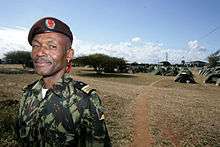
The Mozambican Army was formed in 1976 from three conventional battalions, two of which were trained in Tanzania and a third of which was trained in Zambia.[13] Army officer candidates were initially trained in Maputo by Chinese military instructors.[13] In March 1977, following Mozambique's Treaty of Friendship and Cooperation with the Soviet Union, officer candidates became eligible for training in various Warsaw Pact member states.[13] The Soviet military mission in Mozambique assisted in raising a new army composed of five infantry brigades and an armored brigade.[13] At the height of the civil war, this was gradually increased to eight infantry brigades, an armored brigade, and a counter-insurgency brigade[13] modeled after the Zimbabwean 5th Brigade.[14]
The preexisting army was abolished after the end of the civil war under the auspices of the Joint Commission for the Formation of the Mozambican Defence Force (CCFADM), which included advisers from Portugal, France, and the United Kingdom.[13] The CCFADM recommended that former army personnel and an equal number of demobilised RENAMO insurgents be integrated into a single force numbering about 30,000.[13] Due to logistics problems and budgetary constraints, however, the army only numbered about 12,195 in 1995.[13] Force levels rarely fluctuated between 1995 and the mid-2000s due to the army's limited resources and low budget priority.[13]
In 2016, the Mozambican Army consisted of 10,000 troops organised into three special forces battalions, seven light infantry battalions, two engineer battalions, two artillery battalions, and a single logistics battalion.[15]
As of 2017, the serving chief of the army was Major General Eugènio Dias Da Silva.[16]
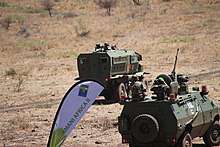
Equipment
Between 1977 and 1989, the Mozambican Army was lavishly supplied with Soviet weapons, as well as a Soviet-supervised technical programme to oversee their logistics needs and maintenance.[17] Following the collapse of the Soviet Union in 1991, along with the resulting departure of Soviet technical staff, much of this equipment was rendered inoperable.[17] The bulk of the army's hardware remained vested in this ageing and increasingly obsolescent Soviet equipment throughout the 2000s, and serviceability rates have remained low.[15] In 2016, less than 10% of the army's artillery and armoured vehicles were operational.[15]
Small arms
| Weapon | Type | Origin | Notes | |||
|---|---|---|---|---|---|---|
| Pistols | ||||||
| Browning Hi-Power[18] | Semi-automatic pistol | |||||
| Makarov[18] | Semi-automatic pistol | |||||
| Stechkin[18] | Automatic pistol | |||||
| TT pistol[18] | Semi-automatic pistol | |||||
| Walther P38[18] | Semi-automatic pistol | |||||
| Submachine guns | ||||||
| FBP[18] | Submachine gun | |||||
| Franchi LF-57[18] | Submachine gun | |||||
| Sa vz. 23[18] | Submachine gun | |||||
| Škorpion vz. 61[19] | Submachine gun | |||||
| Star Model Z84[18] | Submachine gun | |||||
| Rifles | ||||||
| SKS[19] | Semi-automatic rifle | |||||
| AK-47[18] | Assault rifle | |||||
| AKM[18] | Assault rifle | |||||
| vz. 58[18] | Assault rifle | |||||
| FN FAL[19] | Battle rifle | |||||
| Machine guns | ||||||
| RPK[19] | Light machine gun | |||||
| ZB vz. 37[18] | General-purpose machine gun | |||||
| Rheinmetall MG 3[18] | General-purpose machine gun | Italian Beretta MG 42/59 variant.[18] | ||||
| PK[18] | Medium machine gun | |||||
| DShK[19] | Heavy machine gun | |||||
| SG-43 Goryunov[18] | Heavy machine gun | |||||
Heavy weapons
| Weapon | Type | Origin | Notes | |||
|---|---|---|---|---|---|---|
| Anti-Tank | ||||||
| B-10[18] | Recoilless rifle | |||||
| B-11[18] | Recoilless rifle | |||||
| RPG-7[20] | Rocket-propelled grenade | |||||
| 9M14 Malyutka[18] | Anti-tank guided missile | |||||
| 9K111 Fagot[18] | Anti-tank guided missile | |||||
| Air Defence | ||||||
| ZU-23-2 | Anti-aircraft gun | 120 in service.[20][15] | ||||
| 61-K | Anti-aircraft gun | 90 in service; 10 in storage.[15] | ||||
| AZP S-60 | Anti-aircraft gun | 60 in service; 30 in storage.[15] | ||||
| ZSU-57-2 | Self-propelled anti-aircraft gun | 20 in service.[20][15] | ||||
| S-125 Neva/Pechora[21] | Surface-to-air missile | 103 originally acquired.[22] | ||||
| 9K31 Strela-1[22] | Surface-to-air missile | |||||
| 9K32 Strela-2 | Surface-to-air missile | 20 operational.[20] Up to 250 in storage.[23] | ||||
| Artillery | ||||||
| BS-3 | Field gun | 20 in service.[20][15] | ||||
| M-30[22] | Howitzer | |||||
| D-30 | Howitzer | 12 in service.[20][15] | ||||
| M-46 | Field gun | 6 in service.[24] | ||||
| D-1 | Howitzer | 12 in service.[24][15] | ||||
| ZiS-3 | Field gun | 180 in service.[20] | ||||
| D-48 | Anti-tank gun | 6 in service.[24] | ||||
| Type 56 | Field gun | 12 in service.[24][15] | ||||
| BM-12 | Multiple rocket launcher | 12 in service.[24][15] | ||||
| BM-21 Grad | Multiple rocket launcher | 12 in service.[25] | ||||
| 120-PM-43 | Heavy mortar | 12 in service.[24][15] | ||||
| 82-BM-37 | Infantry mortar | 40 in service.[24][15] | ||||
Vehicles
| Vehicle | Type | Origin | Notes | |||
|---|---|---|---|---|---|---|
| Tanks | ||||||
| T-55 | Main battle tank | 90—110 originally in service;[22] status uncertain.[23] | ||||
| T-54 | Main battle tank | 60 originally in service;[22] status uncertain.[23] | ||||
| PT-76 | Light tank | 16 in service.[20][21] | ||||
| Armoured cars | ||||||
| BRDM-1 | Scout car | 31 originally in service;[22] >28 operational.[20] | ||||
| BRDM-2 | Scout car | 56 originally in service;[22] >28 operational.[20] | ||||
| Armoured personnel carriers and infantry fighting vehicles | ||||||
| BTR-40[21] | APC | |||||
| BTR-152 | APC | 60—100 in service.[20][15] | ||||
| BTR-60 | APC | 80—160 in service.[20][15] | ||||
| Saxon | APC | 25 in service.[15][22] | ||||
| FV432 | APC | 30—40 in service.[15][22] | ||||
| WZ551 | APC | 30-35 in service | ||||
| BMP-1 | IFV | 40 in service.[15][20] | ||||
| Utility vehicles | ||||||
| K61 GPT[21] | Amphibious transporter | |||||
| EQ2050 | off-road vehicle | |||||
Air Force
The Mozambique Air Force (Forca Aérea de Moçambique) or FAM was part of the national army initially, and from 1985 to 1990 was known as the People's Liberation Air Force (Força Aérea Popular de Libertação). Due to Mozambique's history, the air force has a history of using former Portuguese aircraft, ever since its setting-up after independence in 1975, supported by Cuba and the USSR. As such there was an inflow of Soviet-built aircraft to support the government in the civil war up to 1992. Following the ceasefire in that year the change in government policies towards Western-style economics meant that Cuban support for the Air Force dwindled and most of the aircraft have fallen into disrepair at the three main bases of Beira, Nacala and Nampula. The FAM is now effectively a token force, and the defence budget has been cut down to 1.5 percent of Mozambique's Gross National Product.[26] The number of personnel in the Air Force are estimated at 4000.
In 2011, the Portuguese Air Force offered FAM two Cessna FTB-337, updated with the latest technology for the use in training, aeromedical evacuation and maritime surveillance operations. This is part of the permanent technical-military cooperation (CTM) programme between Portugal and Mozambique. Regarding specifically the FAM, the Portuguese-Mozambican cooperation also includes other actions as the training of pilot officers, NCOs and aviation technicians, the creation of the aviation medicine and the air operations centers and the development of the search and rescue and flight safety capabilities. Also, several Mozambican officer cadets attend the Portuguese Air Force Academy.
In 2014, the Brazilian Minister of Defense disclosed its intention to donate 3 Embraer EMB 312 Tucano and assist on financing the purchase of 3 Embraer EMB 314 Super Tucano.[27]
In 2014, Mozambique News and Clippings 256 (Hanlon, J)reported the following: "The Romanian company Aerostar has completed the overhaul and upgrade of eight Mozambique Air Force MiG-21 fighters, some of which had not flown operationally for more than 20 years. The package also included the overhaul of a L-39 jet trainer along with six single-seat Mig-21 fighter jets and two double-seat MiG-21 trainer aircraft, as well as a full training programme for ground staff and pilots. Two R-40S basic trainer aircraft were also delivered. Six MiG-21s are now back in Mozambique with the final two aircraft shipped from Romania in early July".
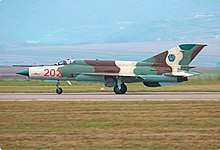
Current inventory
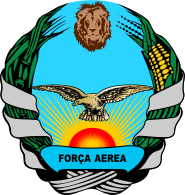
| Aircraft | Origin | Type | Variant | In service | Notes | |
|---|---|---|---|---|---|---|
| MiG-21 | Soviet Union | fighter | 8[28] | |||
| Embraer EMB-312 Tucano | Brazil | patrol | 3 | |||
| Transport | ||||||
| An-26 | Ukraine | transport | 1[28] | |||
| Cessna FTB-337 | United States | transport | 3 | |||
| Helicopters | ||||||
| Mil Mi-8 | Russia | utility | 6[28] | |||
| Mil Mi-24 | Russia | attack | Mi-25 | 2[28] | ||
| Trainer Aircraft | ||||||
| Aero L-39 | Czech Republic | jet trainer | 2[28] | |||

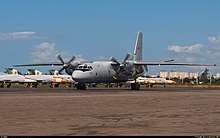
Navy
There are about 2000 personnel in the navy. In September 2004 it was reported that the South African Navy was to donate two of its Namacurra class harbour patrol boat to the Mozambique Navy. The boats were refitted by the naval dockyard at Simon's Town and equipped with outboard motors and navigation equipment donated by the French Navy. The French Navy Durance class command and replenishment oiler Marne (A360) was to deliver the boats to Maputo en route to its ALINDIEN operational area in the Indian Ocean after a refit in Cape Town.[29]
In 2013, the French shipyard CMN Group confirmed a major order by Mozambique, including 6 patrol vessels & interceptors.[30] On July 29, 2019 in the first ever visit by an Defence Minister of India Rajnath Singh donated 2 L&T class Fast interceptor boats to the Navy. A team from Indian Coast Guard will also be stationed to train the crew, support for maintenance and operation of the two boats.[31]
Equipment
- PCI-class inshore patrol boat (3 ordered, non-operational)
- Pebane (P-001) ex-Spanish navy Dragonera (P-32) ( 85 tons, 32 meters ) transferred after refit 2012 from the Spanish Navy[32] for a symbolic price (€100).
References
- Military Technology, World Defence Almanac, Vol. XXXII, Issue 1, 2008, p.323
- IISS Military Balance 2007, p.284
- ‘Final Report of the Secretary-General on the United Nations Operation in Mozambique,’ S/1994/1449, 23 December 1994
- "Suppressing the Revival of Conflict in Mozambique through Inclusive National Dialogue". ACCORD. Retrieved 28 May 2020.
- Reuters, Mozambique leader Guebuza sacks defence chiefs, 2008
- World Library. "A History of the Mozambican Civil War" (PDF). www.worldlibrary.org. Retrieved 28 May 2020.
- "Mozambique: New Ministers Sworn in". allAfrica.com. 27 March 2008. Retrieved 18 April 2008.
- "Mozambique defence minister axed a year after arms depot tragedy". International News Service. 26 March 2008. Retrieved 23 April 2008.
- "Mozambique: Guebuza Sacks Defence Minister". allAfrica.com. 26 March 2008. Retrieved 18 April 2008.
- Richard Synge, Mozambique: UN Peacekeeping in Action, 1992-94, United States Institute of Peace Press, Washington, D.C., 1997, p.105
- "Archived copy". Archived from the original on 27 April 2010. Retrieved 27 November 2010.CS1 maint: archived copy as title (link)
- Helmoed-Romer Heitman, 'Burundi mission at full strength,' Jane's Defence Weekly, 29 October 2003, 16.
- Coelho, Joao-Paulo Borges; Malache, Adriano; Macaringue, Paulino (2015). "Profound transformations and regional conflagrations: The history of Mozambique's armed forces from 1975–2005" (PDF). Pretoria: Institute for Security Studies. Archived from the original (PDF) on 19 March 2018. Retrieved 19 March 2018.
- Bermudez, Joseph (1997). Terrorism, the North Korean connection. New York: Crane, Russak & Company. p. 124. ISBN 978-0844816104.
- International Institute for Strategic Studies (IISS) (2016). The Military Balance 2016. London: IISS. pp. 457–458. ISBN 978-1857438352.
- Indiablooms. "Sunil Lanba visits Mozambique, Tanzania | Indiablooms - First Portal on Digital News Management". Indiablooms.com. Retrieved 24 July 2017.
- Howe, Herbert (2004). Ambiguous Order: Military Forces in African States. Boulder, Colorado: Lynne Reinner Publishers. pp. 59–60. ISBN 978-1588263155.
- Hogg, Ian. Jane's Infantry Weapons, 1991-1992 (1992 ed.). Macdonald and Jane's Publishers Ltd. p. 747. ISBN 9780710609632.
- "SALW Guide: Global distribution and visual identification (Mozambique country report)" (PDF). Bonn: Bonn International Center for Conversion. 2016. Archived from the original (PDF) on 19 March 2018. Retrieved 19 March 2018.
- Kruger, Anton; Martin, Guy (23 August 2013). "Armed Forces for the Defence of Mozambique". Johannesburg: DefenceWeb. Archived from the original on 19 March 2018. Retrieved 19 March 2018.CS1 maint: BOT: original-url status unknown (link)
- Keegan, John (1983). World Armies (Second ed.). Basingstoke: Palgrave-Macmillan. p. 408. ISBN 978-0333340790.
- SIPRI, (various) (2016). "Trade Registers". Solna: Stockholm International Peace Research Institute. Retrieved 17 August 2016.
- Hussein, Solomon (1988). Towards a Common Defence and Security Policy in the Southern African Development Community. Pretoria: Africa Institute of South Africa. pp. 102–103. ISBN 978-0798301749.
- "Future Artillery Systems: 2016 Market Report" (PDF). Tidworth: Defence IQ. 2016. Archived from the original (PDF) on 5 August 2016. Retrieved 21 January 2017.
- World Aircraft Information Files. Brightstar Publishing, London, File 340 Sheet 05
- Barreira, Victor (23 March 2014). "Brazil seeks to boost defence exports to Africa". IHS Jane's. Retrieved 13 May 2014.
- "World Air Forces 2017". Flightglobal Insight. 2017. Retrieved 17 October 2017.
- Helmoed-Romer Heitman, 'SAN patrol boats gifted to Mozambique,' Jane's Defence Weekly, 1 September 2004, p.17
- http://worlddefencenews.blogspot.com/2013/09/french-shipyard-cmn-confirms-major.html
- "India hands over two Fast Interceptor boats to Mozambique".
- "La Armada española transfiere el patrullero 'Conejera' a la Marina de Senegal". spanish navy web. 21 February 2012. Retrieved 22 February 2012.
- Hoyle, Craig. "World Air Forces Directory". Flight International, Vol. 182 No. 5370. pp. 40–64. ISSN 0015-3710.
Further reading
- Protocol on the Formation of the FADM, Rome 1992
- Cameron R. Hume, Ending Mozambique's War: The Role of Mediation and Good Offices, U.S. Institute of Peace, Washington DC, 1994
- Lundin, Irae B, Martinho Chachiua, Anthonio Gaspar, Habiba Guebuzua, and Guilherme Mbilana (2000). Reducing Costs through an Expensive Exercise: The Impact of Demobilization in Mozambique, in Kees Kingma (ed.) Demobilization in Sub-Saharan Africa: The Development and Security Impacts, Basingstoke, UK: MacMillan, 173-212
- Anica Lala, Security sector reform in post-conflict environments: An analysis of coherence and sequencing in Mozambique. Examining Peacebuilding Challenges of Defence, Police and Justice Reforms in a Neo-Liberal Era, 2014 Bradford thesis
- Anica Lala, Security and Democracy in Southern Africa: Mozambique, 2007
- Paulino Macaringue, "Civil-Military Relations in Post-Cold War Mozambique," Ourselves to Know, Institute for Security Studies, 2002.
- Martin Rupiya, 'Historical Context: War and Peace in Mozambique,' in Jeremy Armon, Dylan Henrickson and Alex Vines, eds, The Mozambican Peace Process in Perspective, London: Conciliation Resources Accord Series, 1998
- Richard Synge, Mozambique: UN Peacekeeping in Action, 1992–94, United States Institute of Peace Press, Washington, D.C., 1997 - includes details on formation of FADM
- Eric T. Young, The Development of the FADM in Mozambique: Internal and External Dynamics, African Security Review, Vol. 5, No. 1, 1996
- Joao Porto, Mozambique contributes to the African Union Mission in Burundi, April 2003
External links
- United States Marine Corps, Brotherhood of Arms- story of one Mozambiqican officer's career
- https://wikileaks.org/plusd/cables/1976MAPUTO00888_b.html - details in 1976
![]()
| Wikimedia Commons has media related to Military of Mozambique. |
